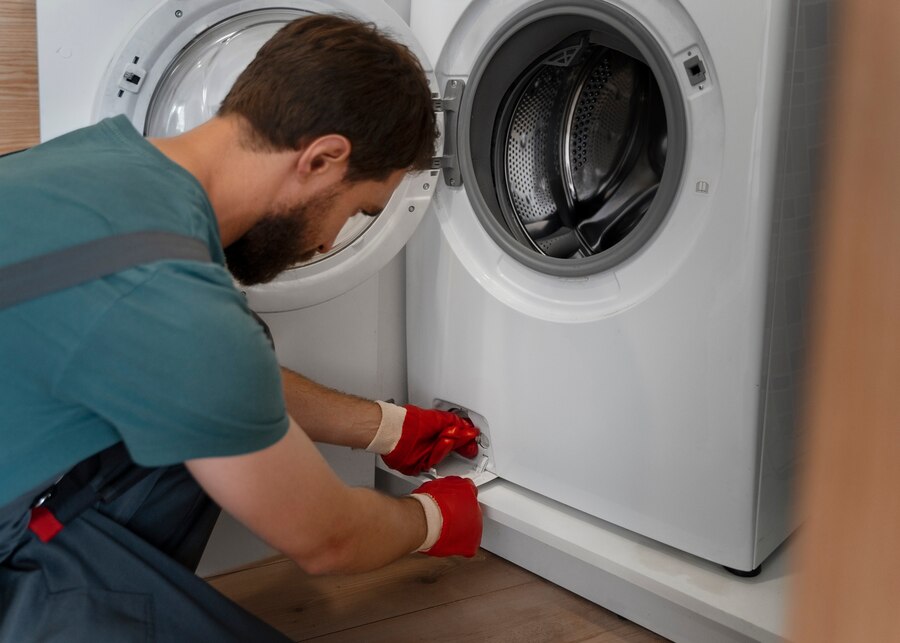In most homes, a washing machine is a necessary item that may create a lot of trouble when it breaks down. One of the most critical components of a washing machine is the drain pump, which plays a vital role in draining water from the washing drum after a cycle. A faulty drain pump can lead to water not being drained properly, leaving clothes wet, and causing further damage to the machine. Recognizing the signs of a bad washing machine drain pump early can save you time, money, and prevent additional damage to the machine.
This post will discuss the typical signs of a malfunctioning washing machine drain pump, how to identify the issue, and how to replace or repair the pump. We will also include charts, data, and troubleshooting tips to help you better understand how to identify a faulty drain pump.

What Is the Drain Pump in a Washing Machine?
It is an essential component that ensures water is expelled efficiently from the washing machine during and after the spin cycle. The drain pump works by pulling water out of the drum through the drain hose and into your household plumbing system.
There are two primary varieties of drain pumps for washing machines:
- Centrifugal Pumps: These are the most common in modern washing machines. They use a spinning mechanism to move water out of the drum.
- Peristaltic Pumps: These are less common and use a squeezing action to push water out.
Regardless of the type, a malfunctioning drain pump can cause issues with the washing machine, ranging from water drainage problems to complete failure to drain water.

Warning Signs of a Broken Washing Machine Drain Pump
The water does not drain properly.
The most obvious sign of a bad drain pump is water remaining in the drum after a cycle. A blocked, damaged, or malfunctioning drain pump may be the cause of your washing machine’s improper water outflow.
How to Check:
Check to see if the water is draining from the drum after a few minutes of starting a spin cycle. If the water stays in the drum, the pump might not be working properly.
Loud Noises During the Drain Cycle
Another common symptom of a failing drain pump is unusual or loud noises coming from the washing machine, especially during the draining or spin cycle. The pump may be clogged, or there could be a problem with its motor, causing it to make grinding or buzzing noises.
How to Check:
Listen for any loud or unusual sounds when the machine tries to drain. A buzzing or grinding sound may indicate debris inside the pump or a malfunctioning motor.
Water Leaking Around the Pump Area
A faulty drain pump can sometimes cause water to leak around the base of the washing machine. If the pump seal is damaged or the pump itself is cracked, water may leak from the pump area during the draining process.
How to Check:
Look for any puddles of water underneath the washing machine, particularly around the drain pump area. If water is leaking from there, the pump may need to be replaced.
Machine Displaying an Error Code
Modern washing machines often have error codes that are designed to alert users to specific malfunctions, including issues with the drain pump. Some machines will display a code indicating that the drain pump is faulty or there is an issue with water drainage.
How to Check:
To comprehend the trouble codes, see your washing machine’s user handbook. Common codes related to drainage issues include:
- E21, E22, or E23 (for front-load washers)
- F02 or F21 (for Whirlpool)
- OE (for Samsung)
Clothes Not Fully Spinning Dry
If your washing machine’s spin cycle is not working properly, leaving clothes wet or soaking, this could be a sign that the pump is unable to drain the water fully. Without proper drainage, the spin cycle cannot work as intended, leaving clothes damp at the end of the cycle.
How to Check:
After the spin cycle, check to see if clothes are excessively wet. If this is a recurring issue, the drain pump might be to blame.
Drain Pump Continuously Running
If you notice that the pump seems to be constantly running even when the machine is not draining, it could indicate an issue with the pump’s motor or electrical components. The drain pump might be stuck in the “on” position due to a faulty control board or pump motor.
How to Check:
Observe the drain pump’s operation. If it does not stop during the washing cycle, it may be malfunctioning.
How to Diagnose a Bad Drain Pump
Examine the drain hose for obstructions.
Before jumping to the conclusion that the pump itself is faulty, always start by checking the drain hose for any blockages. Water may not drain correctly due to a plugged hose.
Steps to Inspect:
- Unplug the washing machine from the power source and turn it off.
- Take the machine’s drain hose out of the back and check it for debris, kinks, or obstructions.
- If the hose is blocked, clean it thoroughly and reattach it.
Check for Debris Inside the Pump
When debris becomes lodged inside the drain pump, it can stop working correctly. Small items like lint, coins, and pieces of fabric can accumulate in the pump or the impeller.
Steps to Check:
- Turn off and unplug the washing machine.
- Locate the drain pump filter or access panel (depending on the model).
- Open the panel and inspect the pump for debris.
- Remove it carefully and retest the pump if you discover any.
Test the Pump Motor
The motor may be the problem if the pump is still not draining. The pump may malfunction or cease to operate completely due to a malfunctioning motor. You can check the motor’s continuity using a multimeter.
Steps to Test the Motor:
- Turn off the washing machine and unplug it.
- Disconnect the wires from the pump motor.
- Place probes on motor terminals and set multimeter continuity.
- If the multimeter shows no continuity, the motor is likely faulty and needs replacement.
Inspect the Pump for Physical Damage
Over time, the drain pump may suffer physical damage, especially if it is made of plastic. Look for any visible cracks, wear, or broken parts around the pump assembly.
Steps to Inspect:
- Disconnect the pump from the washing machine and visually inspect it.
- Inspect for signs of wear or cracks.
- If the pump is damaged, replacement will be required.
How to Fix or Replace a Bad Drain Pump
If you’ve determined that your drain pump is faulty, you can either attempt to repair it or replace it entirely. Here’s how:
Repairing the Drain Pump
If the problem is caused by debris or a minor blockage, you may be able to clean and repair the pump without replacing it. To clean the pump and hose, according to the previously mentioned procedures.
Replacing the Drain Pump
If the pump is physically damaged or the motor is faulty, you’ll need to replace it with a new one.
Steps to Replace the Pump:
- Unplug the washing machine and turn off power.
- Find the pump, which is often located at the machine’s bottom.
- Disconnect all electrical connections and hoses, and take out the screws holding the pump in place.
- Remove the malfunctioning pump and replace it.
- Reattach the electrical parts and hoses.
- Secure the pump in place with screws and test the machine to ensure it’s draining properly.
Conclusion
A faulty washing machine drain pump can cause a range of issues, including improper drainage, unusual noises, and wet clothes.If you notice any of these signs, it’s crucial to identify the issue promptly to avoid further damage to the machine. You can identify whether the pump is defective and whether a repair or replacement is required by using the diagnostic procedures described in this article.
Regular maintenance and cleaning of the drain pump, hoses, and filter can help prevent common issues and extend the life of your washing machine. If you’re unable to fix the problem yourself, contacting a professional technician is always a good option to ensure that your washing machine is functioning optimally.
| Symptom | Possible Cause |
| Water not draining | Clogged or faulty pump |
| Loud noise during drainage | Blockage or worn-out motor |
| Water leaking | Damaged pump or seal |
| Error code on display | Faulty drain pump or control board |
| Clothes not fully drying | Insufficient drainage or pump failure |
Taking care of your washing machine and addressing drain pump issues promptly will keep it running efficiently and prevent costly repairs down the line.

